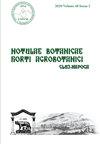评估罗马尼亚西南部有机耕作条件下普通小麦(Triticum aestivum L.)的产量和质量
IF 1.3
4区 生物学
Q3 PLANT SCIENCES
引用次数: 0
摘要
考虑到对有机小麦需求的不断增长,以及保证作物高产优质的需要,栽培品种的选择起着至关重要的作用。只有采用最适合有机农业的栽培品种,才能实现这些预期目标。本研究的目的是根据对有机农户和加工商来说三个重要的参数,即谷物产量、测试重量和蛋白质含量,来评估 15 个小麦栽培品种是否适合在有机农业中种植。田间试验在奥尔特尼亚地区(罗马尼亚西南部)中心的有机农业条件下连续进行了两个生长季。结果表明,研究年份的气候条件以及栽培品种对所有研究参数都有显著影响。基因型与环境的交互作用仅对试验重量和蛋白质含量有显著影响。在两年的研究中,平均每公顷谷物产量为 3899 千克,测试重量为 70.8 千克/升,蛋白质含量为 10.1%。最近发布的栽培品种 "Voinic "获得了最高的谷物产量(4755 千克/公顷-1),以及最高的测试重量和蛋白质含量(73.9 千克/升-1,分别为 10.7%)。总之,通过使用适合有机农业的栽培品种,可以获得优质的产量,从而成为烘焙业的合适原料。本文章由计算机程序翻译,如有差异,请以英文原文为准。
Assessment of common wheat (Triticum aestivum L.) yield and quality under organic farming in the southwest of Romania
Taking into account the rising demand for organic wheat and the need to guarantee both high productivity and quality of the crops, the choice of cultivar plays a crucial role. These intended objectives may solely be attained by employing the most appropriate cultivars for organic agriculture. The aim of this study was to evaluate the suitability of 15 wheat cultivars for cultivation in organic farming according to three important parameters for organic farmers and processors, namely grain yield, test weight and protein content. The field experiment took place over two consecutive growing seasons, in the center of the Oltenia region (southwest of Romania) under organic farming conditions. The results showed significant effects of the climatic conditions in the year of study, but also of the cultivar on all studied parameters. The effect of genotype-environment interactions was significant only for test weight and protein content. On average, over the two years of study, the grain yield was 3899 kg ha-1, the test weight was 70.8 kg hl-1, and the protein content was 10.1%. The recently released cultivar ‘Voinic’ obtained the maximum grain yield (4755 kg ha-1) and also a maximum test weight and protein content (73.9 kg hl-1, respectively 10.7%). In conclusion, it follows that by using cultivars suitable for organic farming, good and quality yields can be obtained that can be a suitable raw material for baking industry.
求助全文
通过发布文献求助,成功后即可免费获取论文全文。
去求助
来源期刊

Notulae Botanicae Horti Agrobotanici Cluj-napoca
PLANT SCIENCES-
CiteScore
2.70
自引率
0.00%
发文量
118
审稿时长
3 months
期刊介绍:
Notulae Botanicae Horti Agrobotanici Cluj-Napoca is a peer-reviewed biannual journal aimed at disseminating significant research and original papers, critical reviews and short reviews. The subjects refer on plant biodiversity, genetics and plant breeding, development of new methodologies that can be of interest to a wide audience of plant scientists in all areas of plant biology, agriculture, horticulture and forestry. The journal encourages authors to frame their research questions and discuss their results in terms of the major questions of plant sciences, thereby maximizing the impact and value of their research, and thus in favor of spreading their studies outcome. The papers must be of potential interest to a significant number of scientists and, if specific to a local situation, must be relevant to a wide body of knowledge in life sciences. Articles should make a significant contribution to the advancement of knowledge or toward a better understanding of existing biological and agricultural concepts. An international Editorial Board advises the journal. The total content of the journal may be used for educational, non-profit purposes without regard to copyright. The distribution of the material is encouraged with the condition that the authors and the source (Notulae Botanicae Horti Agrobotanici Cluj-Napoca or JCR abbrev. title Not Bot Horti Agrobo) are mentioned.
 求助内容:
求助内容: 应助结果提醒方式:
应助结果提醒方式:


